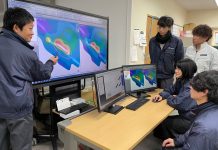
Significant wrinkling in draw operation? What leads to this behavior?
As a provider of software for metal forming simulation, on occasion customers will contact our support with concerns about simulation results that differ from reality. When this happens one of our knowledgeable support engineers will delve into the issue with inquiries about the input simulation parameters, material properties selection, stamping process definition, or any number of possible user defined inputs that could lead to the difference. However, one of the questions that comes often far too late in the discussion is whether or not the physical tool is, in fact, set up to “production intent”.
Tryout is the event in the tool engineering and manufacturing process when the tool is loaded into the press and attempts to achieve first successful part production. In most cases, tryout is merely a final validation that the engineering assumptions made until that point can produce the desired results—anecdotal feedback indicates that it is largely successful. Engineering enabled through the use of Finite Element Analysis tools like the AutoForm software has significantly reduced the unknowns during die tryout. There are still occasions where the results can be different than predicted. The fault may not always be with the simulated process. As with anything designed and then built there is always the potential for differences between the “as engineered” state and the “as built” state.

Draw-in -movement of the blank material to the final position in the formed part
Common simulation inputs like friction, bead restraint, pad and binder forces are input in a way that is not controlled in the same manner during die tryout or production-there is no “friction dial” on the production line. Additionally, as tooling is built from CAD designs to foam patterns for casting, from raw castings into assembled and machined tool sets, there are many opportunities for deviation from the intended tool design and behavior. Then how can a die shop evaluate if the die that they are building is recreating the metal forming conditions that enabled the design to pass engineering? One direction that simulation experts promote is to “match the draw-in”.
The exercise of matching the draw-in forces the tool makers to adjust the behavior of the physical die to attain similar material flow during the forming process. Often times the bead effect from simulation may differ from the response of the bead in the physical tool. There is no silver bullet to assure that the modeled beads, binder pressure, tool/sheet/lube interaction all achieve the same effect in real tools as simulation. However, if we have matching draw-in the effective restraint is at least very close.

Draw-in measurements from simulation are easily captured, displayed, and evaluated
Draw-in from simulation is relatively straightforward to measure. From the original location of the blank edge to the final location; how far does the material move? Because of the nature of the simulation, the precise movement can be computed and shown—the computer knows where the blank starts and knows where it ends. But in reality is it so easy to measure the draw-in?
The starting location of the blank is not necessarily completely known or repeatable during tryout. The initial size and shape of the blank might vary from design intent. Computer simulation can assess draw-in from different moments in the forming stroke; like from initial bead formation to bottom of the forming stroke. In a stamping press can one make similar measurements?
- Do you measure draw-in during tryout (or production) to evaluate if tool is running at “engineering intent”?
- How and where do you measure the draw-in?
- When draw-in varies from expected values, how do you identify which variables in the process changed?
We would love to hear what you think. Comment below if you use draw-in as a tool when correlating simulation to reality.














I enjoyed reading your post and would like to offer actual verifiable results: In my experience, when the dies were designed and built to the exact specifications of the AutoForm simulation model, the actual physical results had dead nuts correlation to the predicted results without exception. This is true for automotive body-in-white panels, structural components, and safety critical stampings and for appliance Class A stampings.
Every single time that someone thought they knew better because their experience as more reliable than simulation technology in their mind and did not follow the simulation model, the physical result was worse than the predicted result without exception. And every time, the corrective action was to rework the die in compliance with the virtual model.
To answer the question posed in your post, yes, I use draw-in as a preliminary indicator of correlation to the simulation. I will perform at thinning limit analysis on actual stampings, rerun the simulation to actual material mechanical properties, and overlay the Thinning Limit Diagrams and determine pass / fail. In other words, if the actual TLD is as safe or safer than the predicted TLD: pass. Otherwise, fail.
Thank you Tim. Your feedback is most welcome and also brings up many additional topics that we plan to address here.
Rerunning the simulation with actual material properties being one we should address soon.
Fair enough. The whats and whys of material properties could fill its own blog. Most folks I run into out there in the trenches use either ideal forming properties for a given material type or use a concoction of worst case mechanical values. The ideal is unattainable day-to-day and the worst case Frankenstein approach has no correlation to anything found in the trenches at the press.
Starting with actual properties for what I call the Certification simulation is a good starting point and I look forward to reading more on the official AutoForm blog soon.
Hello everybody,
I have one question from stamping process and evaluation of Contact Pressure (or Max Contact Pressure). What do you mean? Do you have any experience from this? How evaluate the criteria, because when i have more contact pressure than definite limit => problem with stamping process risk of splits, thinning, springback ets… What do you Think?
Contact pressure is not a “criteria” output value. Meaning that there is no defined “safe” or “fail” contact pressure limit. There is no define minimum or maximum allowed value.
You might be thinking that because the word “Max.” is included in the output name, that this is the case. However, the inclusion of the word “Max.” in the description is not indicating that there is an upper limit to the contact pressure, instead it means that when this output variable is selected you are viewing the highest recorded value in the FEA meshes simulation history for “contact pressure”; as opposed to viewing the “instantaneous contact pressure” which would be that output variable at the single timestep being viewed.